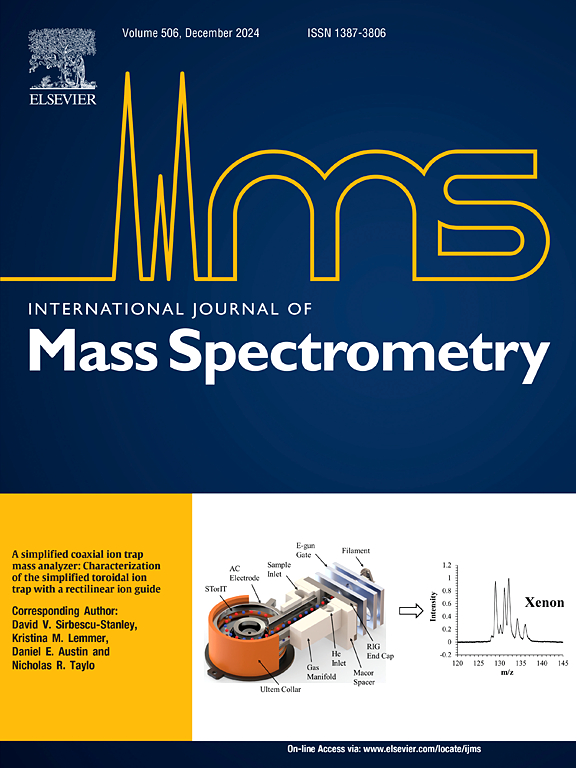All-ions laser induced dissociation (AI-LID) in the C-trap of a Q Exactive: Data independent identification and quantification directly from ultra-high resolution differential mass spectra
IF 1.7
3区 化学
Q3 PHYSICS, ATOMIC, MOLECULAR & CHEMICAL
引用次数: 0
Abstract
An analytical method is demonstrated which allows to follow a data independent, all ion fragmentation (AIF) acquisition procedure, but to fall back on a standard and generic data-dependent acquisition (DDA) analysis procedure for the data treatment: searching databases with individual precursor ions and fragments lists. This method is implemented with photo-activation (LID) in the visible range which allows extreme specificity and sensitivity, and is demonstrated on Cysteine-containing tryptic peptides grafted with a chromophore. This proof of concept relies on the efficient implementation of LID directly in the C-trap of a ThermoScientific QExactive mass spectrometer during ion accumulation, before full MS detection. Laser irradiation turned alternatively ON and OFF after each full MS allows to build differential mass spectra in which non-dissociating ions are cancelled out while fragmenting precursors and fragments show up with opposite signs, which enables to build precursor/fragments lists for database search. Protein identification was demonstrated with remarkably low false discovery rates. Relative quantification was also demonstrated by integration of precursor and fragment ion elution peaks after differential analysis and limits of quantifications were demonstrated down to 11 ng of proteins injected. This mixed approach takes the best of both worlds – the deep proteome coverage of DIA, with the exhaustive fragmentation of all precursor ions, and the reliability and ease of use of classical DDA database search, relieving the need for the initial constitution of a spectral library.

Q萃取物c阱中全离子激光诱导离解(AI-LID):直接从超高分辨率微分质谱数据独立鉴定和定量
本文演示了一种分析方法,该方法允许遵循数据独立的、所有离子碎片(AIF)获取过程,但对于数据处理,可以退回到标准的、通用的数据依赖获取(DDA)分析过程:用单个前体离子和碎片列表搜索数据库。该方法在可见光范围内使用光激活(LID)实现,具有极高的特异性和敏感性,并在接枝带有发色团的含半胱氨酸的色氨酸肽上得到了证明。这一概念证明依赖于在离子积累过程中,在全质谱检测之前,在ThermoScientific QExactive质谱仪的c阱中直接有效地实施LID。激光照射在每次全质谱后交替打开和关闭,可以建立微分质谱,其中非解离离子被抵消,而碎片前体和片段显示相反的符号,这使得建立前体/片段列表用于数据库搜索。蛋白质鉴定被证明具有非常低的错误发现率。通过差异分析后前体和片段离子洗脱峰的整合,也证明了相对定量,并证明了定量的限制低至11 ng注射的蛋白质。这种混合方法充分利用了两个方面的优点:DIA的蛋白质组覆盖范围广,所有前体离子的详尽碎片化,以及经典DDA数据库搜索的可靠性和易用性,减轻了谱库初始构建的需要。
本文章由计算机程序翻译,如有差异,请以英文原文为准。
求助全文
约1分钟内获得全文
求助全文
来源期刊
CiteScore
3.60
自引率
5.60%
发文量
145
审稿时长
71 days
期刊介绍:
The journal invites papers that advance the field of mass spectrometry by exploring fundamental aspects of ion processes using both the experimental and theoretical approaches, developing new instrumentation and experimental strategies for chemical analysis using mass spectrometry, developing new computational strategies for data interpretation and integration, reporting new applications of mass spectrometry and hyphenated techniques in biology, chemistry, geology, and physics.
Papers, in which standard mass spectrometry techniques are used for analysis will not be considered.
IJMS publishes full-length articles, short communications, reviews, and feature articles including young scientist features.

 求助内容:
求助内容: 应助结果提醒方式:
应助结果提醒方式:


